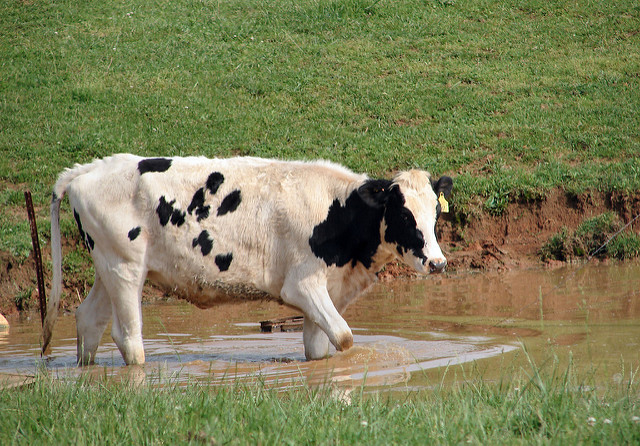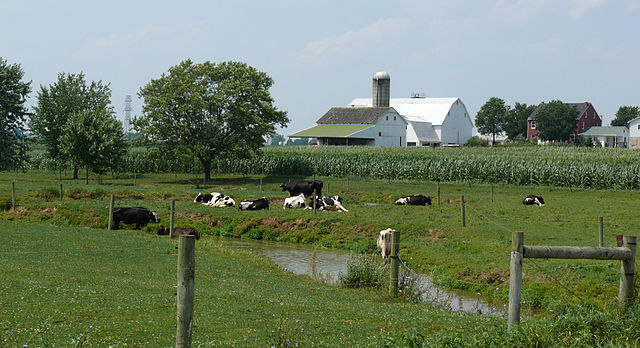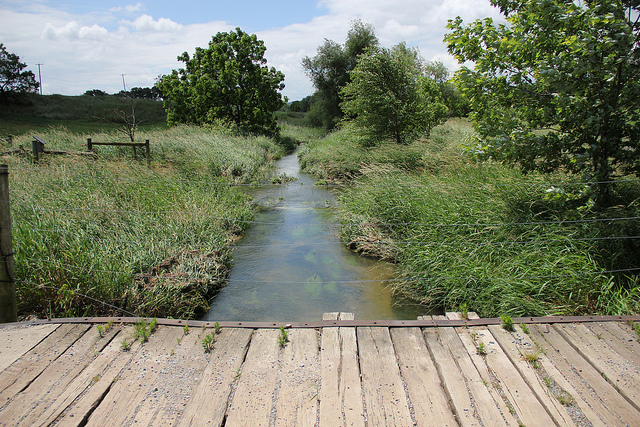Five years ago, the Pennsylvania environmental media highlighted the path-breaking efforts of a Lancaster County Amish farmer to protect his soils and the streams near his property from erosion and pollution.

The efforts of farmer Raymond King to retard soil erosion, plant in contours, and, more than that, to adopt advanced techniques for protecting the environment were reported in a Peaceful Societies news story that year. Assisted by the Chesapeake Bay Foundation (CBF) and other organizations, Mr. King developed better ways of handling manure in his barnyard, planted trees and shrubs along a stream, and erected fencing to keep his cattle out of that stream.
Recently, Mr. King and his Amish farming neighbors were featured again, this time in a cover story of the Bay Journal, a monthly magazine that reports news about the Chesapeake Bay and the surrounding watershed. The bay is the largest estuary on the east coast of the U.S. Organizations such as the CBF are dedicated, in part, to promoting sensible land management practices in the watershed. The rich agricultural farmland of Lancaster County—and in fact much of Central Pennsylvania—is drained by the Susquehanna River and its tributaries, the major river system that empties into the bay.

The recent article written by Donna Morelli sets the scene: a small, unnamed stream flows out of some hills in northeastern Lancaster County and into the pastures of Amish farmers Benuel Zook and then Raymond King. In 2012 the stream ran with mud and manure from hundreds of cows trampling down the stream banks but now, thanks to King and his Amish neighbors, the stream is fenced and the stream banks are covered with trees and shrubs.
Mr. King’s leadoff comments to the reporter, however, attempt to deflect credit away from himself. “Look at my neighbors, they’re the heroes,” King said. “I’m not ahead of anybody.” One of the salient features of the Amish culture, along with numerous other peaceful societies, is to avoid calling attention to oneself, to avoid anything remotely resembling bragging that could lead to envy, jealousy, and possibly violence. The Amish avoidance of being photographed is part of that prohibition. Mr. King clearly didn’t want full credit given to himself—but he was enthusiastic enough about protecting the soil and the water to cooperate with another reporter.

He points out that the five Amish farms along the tiny stream all used CREP money, funds from the Conservation Reserve Enhancement Program of the U.S. government that help farmers install streamside protection measures such as vegetative filtering buffers along streams. Ms. Morelli indicates, however, that not all Amish farmers are willing to cooperate with the government, so the CBF and other NGOs have also gotten involved in supplying advice and money in lieu of the government agencies.
In fact, the article indicates, while some of the Amish and Mennonite farmers remain leery of accepting aid or information from government agencies or anybody else, others are cooperating with the NGOs and still others are acting on their own. But the important development is that the situation regarding pollution and agricultural runoff in the county is improving. The Plain Sect farmers are becoming more environmentally conscious.

According to Christopher Thompson, Manager of the Lancaster County Conservation District, the farmers are under pressure to write farm management plans to help them define their pollution problems and to describe the solutions they will install. Increasingly, the Plain Sect farmers are accepting the financial assistance available to deal with the problems they are causing. And, Mr. Thomson adds, a lot of credit should go to leaders in the Amish community, people such as Mr. King and his neighbor Mr. Zook.
He tells the reporter that it was Mr. Zook who first installed a manure storage system on his dairy farm with assistance from the Natural Resources Conservation Service. His neighbor Mr. King liked the way it operated so he worked with the same agency plus the county conservation district to install a manure storage system on his farm as well.
King then opened his farm to the CBF and to agricultural service agencies so they could begin offering workshops about the matter to other county farmers. The CBF took both neighbors on a boat tour of the Chesapeake Bay so they could observe fishing boats pulling in fish in their nets. “These are all working people,” King said speaking about the fishermen. “We really need to do a better job.”
Ms. Morelli goes on to describe at length the progress in other areas of Lancaster County and the slow but steady acceptance of the need for individuals, particularly the Plain Sect farmers, to make a difference in protecting the bay—and the earth.